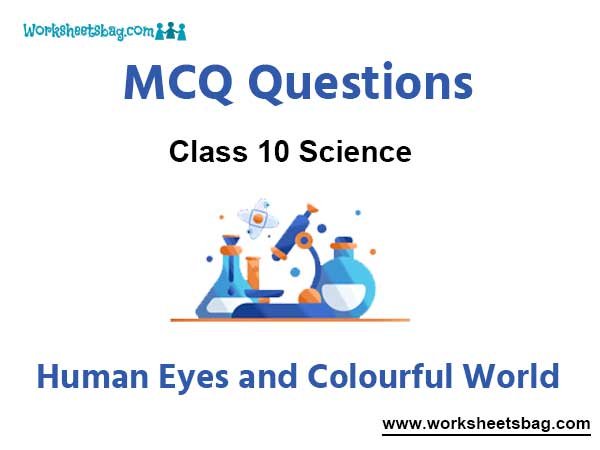Please refer to Human Eyes and Colourful World MCQ Questions Class 10 Science below. These MCQ questions for Class 10 Science with answers have been designed as per the latest NCERT, CBSE books, and syllabus issued for the current academic year. These objective questions for Human Eyes and Colourful World will help you to prepare for the exams and get more marks.
Human Eyes and Colourful World MCQ Questions Class 10 Science
Please see solved MCQ Questions for Human Eyes and Colourful World in Class 10 Science. All questions and answers have been prepared by expert faculty of standard 10 based on the latest examination guidelines.
MCQ Questions Class 10 Science Human Eyes and Colourful World
Question: The human eye forms the image of an object at its
(a) Cornea
(b) Iris
(c) Pupil
(d) Retina
Answer
D
Question: The cells which enable us to distinguish different colours are
(a) Rod shaped
(b) Cone shaped
(c) Both rod and cone shaped
(d) None of these.
Answer
B
Question: The least distance of distinct vision for a young adult with normal vision is about
(a) 25m
(b) 2.5cm
(c) 25cm
(d) 2.5m.
Answer
C
Question: A human eye can focus objects at different distances by adjusting the focal length of the eye lens.
This is due to
(a) Persistence of vision
(b) Near sightedness
(c) Accommodation
(d) Far sightedness
Answer
C
Question: The change in focal length of an eye is caused by the action of
(a) Pupil
(b) Retina
(c) Ciliary muscles
(d) Iris.
Answer
C
Question: A glass prism has
(a) 6 rectangular surfaces
(b) 4 rectangular surfaces
(c) 2 triangular bases and 3 rectangular surfaces
(d) None of the above.
Answer
C
Question: The nature of the eye lens is
(a) Always convex
(b) Always concave
(c) Sometimes convex and other times concave
(d) Cannot say.
Answer
A
Question: How much refraction occurs in the ray passing through a prism?
(a) 1
(b) 4
(c) 3
(d) 2
Answer
D
Question: Angle of deviation is given by
(a) d = i +e – A
(b) d = i – e + A
(c) d = A – i + e
(d) None of these.
Answer
A
Question: A person cannot see distinctly objects kept beyond 2 m. This defect can be corrected by using a lens of power
(a) + 0.5 D
(b) – 0.5
(c) + 0.2 D
(d) – 0.2
Answer
B
Question: Which of the following phenomena of light are involved in the formation of a rainbow?
(a) Reflection, refraction and dispersion
(b) Refraction, dispersion and total internal reflection
(c) Refraction, dispersion and internal reflection
(d) Dispersion, scattering and total internal reflection
Answer
C
Question: Which of the following phenomena contributes significantly to the reddish appearance of the sun at sunrise or sunset?
(a) Dispersion of light
(b) Scattering of light
(c) Total internal reflection of light
(d) Reflection of light from the earth
Answer
B
Question: Twinkling of stars is due to atmospheric
(a) Dispersion of light by water droplets
(b) Refraction of light by different layers of varying refractive indices
(c) Scattering of light by dust particles
(d) Internal reflection of light by clouds
Answer
B
Question: At noon the sun appears white as
(a) Light is least scattered
(b) All the colours of the white light are scattered away
(c) Blue colour is scattered the most
(d) Red colour is scattered the most
Answer
A
Question. A got his eye tested. The optician’s prescription for the spectacles was:
Left eye: −3 D
Right eye: −3.50 D
The person is having a defect of vision called:
(a) Presbyopia
(b) Myopia
(c) Astigmatism
(d) Hypermetropia
Answer
B
Question. How eyes adjust in order to focus the image of near or distant objects on retina?
(a) The lens moves in or out according to the position of the object
(b) The retina moves in or out according to the position of the object
(c) The lens becomes thicker or thinner according to the position of the object
(d) The pupil gets larger or smaller according to the position of the object
Answer
C
Question. With both eyes open, a person’s field of view is about:
(a) 90o
(b) 150o
(c) 180o
(d) 360o
Answer
C
Question. Having two eyes facilitates in:
A: Increasing the field of view
B: Bringing three dimensional view
C: Developing the concept of distance/size.
Then the correct option is/are:
(a) A only
(b) A and B only
(c) B only
(d) A, B and C
Answer
D
Question. When a beam of white light falls on a glass prism, the colour of light which will deviate least is:
(a) Violet
(b) Red
(c) Green
(d) Blue
Answer
B
Question. The star appear shifted from their actual position due to the phenomenon of:
(a) Diffraction of light
(b) Scattering of light
(c) Refraction of light
(d) Reflection of light
Answer
C
Question. Blue colour of the sky is due to the phenomenon of:
(a) Reflection of light
(b) Refraction of light
(c) Dispersion of light
(d) Scattering of light
Answer
D
Question. A man finds it difficult to read the odometer on the dashboard of the car but is able to clearly read a distant road sign. Which of the following statement is correct about this man?
(a) The near point of his eyes has receded away.
(b) The near point of his eyes has come closer to him.
(c) The far point of his eyes has receded away.
(d) The far point of his eyes has come closer to him.
Answer
A
Question. Figure a, b, c respectively; indicate the point in case of:
(a) The Hypermetropia eye, the myopic eye and normal eye
(b) The normal eye, the myopic eye and Hypermetropia eye
(c) The normal eye, the Hypermetropia eye and myopic eye
(d) The myopic eye, the normal eye and Hypermetropia eye
Answer
C
Question. The term “accommodation” as applied to the eye, refers to its ability to:
(a) Control the light intensity falling on the retina
(b) Erect the inverted image formed on the retina
(c) Adjust the focal length of the lens
(d) Vary the distance between the lens and retina
Answer
C
Question. A: Astigmatism usually is caused by an irregularly shaped cornea.
B: Rainbow is the natural phenomenon in which dispersion takes place.
(a) Both ‘A’ and ‘B’ are true statements.
(b) Both ‘A’ and ‘B’ are false statements.
(c) ‘A’ is true while ‘B’ is false.
(d) ‘A’ is false while ‘B’ is true.
Answer
A
Question. A person cannot see the distant objects clearly (though he can see the nearby objects clearly). He is suffering from the defect of vision called:
(a) Cataract
(b) Hypermetropia
(c) Myopia
(d) Presbyopia
Answer
C
Question: The clear sky appears blue because
(a) Blue light gets absorbed in the atmosphere
(b) Ultraviolet radiations are absorbed in the atmosphere
(c) Violet and blue lights get scattered more than lights of all other colours by the atmosphere
(d) Light of all other colours is scattered more than the violet and blue colour lights by the
atmosphere
Answer
C
Question: The danger signals installed at the top of tall buildings are red in colour. These can be easily seen from a distance because among all other colours, the red light
(a) is scattered the most by smoke or fog
(b) is scattered the least by smoke or fog
(c) is absorbed the most by smoke or fog
(d) moves fastest in air
Answer
B
Question: Which of the following statements is correct regarding the propagation of light of different colours of white light in air?
(a) Red light moves fastest
(b) Blue light moves faster than green light
(c) All the colours of the white light move with the same speed
(d) Yellow light moves with the mean speed as that of the red and the violet light
Answer
C
Question: The focal length of the eye lens increases when eye muscles
(a) Are relaxed and lens becomes thinner
(b) Contract and lens becomes thicker
(c) Are relaxed and lens becomes thicker
(d) Contract and lens becomes thinner
Answer
A
Question: The phenomena of light responsible for the working of the human eye is
(a) Reflection
(b) Refraction
(c) Power of accommodation
(d) Persistence of vision
Answer
B
Question: Which of the following phenomena of light are involved in the formation of a rainbow?
(a) Reflection, dispersion and refraction
(b) Refraction, dispersion and total internal reflection
(c) Refraction, dispersion, and internal reflection
(d) Dispersion, scattering and total internal reflection
Answer
C
Question: On entering a glass prism, sun‘s rays are
(a) Deviated and dispersed
(b) Deviated but not dispersed
(c) Dispersed but not deviated
(d) Neither deviated nor dispersed
Answer
A
Question: The persistence of vision of human eye is
(a) 1/10th of a second
(b) 1/16th of a second
(c) 1/6th of a second
(d) 1/18th of a second
Answer
C
Question: Write the relation between angle of the prism, angle of deviation, angle of incidence and angle of emergence
(a) A+ e = I + D
(b) A + D = I + e
(c) A + i = D + e
(d) A – D = I – e
Answer
B
ONE WORD ANSWERS
Question: The Retina contains about ___________ number of cones cells that see colour.
Answer
7 Million
Question: The band of 7 colours formed when white light is passed through the prism is called ___________
Answer
Spectrum
Question: At the point of blind spot there no ___________ and ___________
Answer
Cones & Rods
Question: The process of spitting of white light into its seven constituent colours is called ___________
Answer
Dispersion
Question: The eye lens can change its focal length by changing its thickness with the help of ___________
Answer
Ciliary Muscle
Question: Recombination of seven colours of dispersed white light into white light again is also called _______
Answer
Recomposes
Question:___________ Colour has longer wavelength.
Answer
Red
Question: Sometimes you see a person reading the newspaper by placing it far away from his eyes, he is having ___________ defect.
Answer
Hypermetropia
Question: Sometimes you see a person reading the newspaper by placing it very close to his eyes, he is having ___________ defect.
Answer
Myopia
Question: The scattering of light depends inversely upon the ___________ power of the wavelength.
Answer
Fourth
Question: The fluid present between the pupil and the retina is called___________
Answer
Vitreous Humour
Question:___________ is a defect of the eye in which a membrane covers the eye lens.
Answer
Cataract
Question: ___________ Colour has shorter wave length.
Answer
Violet
Question: ___________ is the lack of ability to distinguish between colours.
Answer
Colour Blindness
Question:For a normal human eye, of an adult, the near point is about ___________
Answer
25 Cm
Question: For a normal eye, the far point is ___________
Answer
Infinity
Question: ___________ is a muscular coloured diaphragm in our eyes.
Answer
Iris
NAME THE FOLLOWING
Question: Name the phenomenon

Answer
Dispersion V – R
Question: Identify the diagram; name the defect how can it be corrected?

Answer
Myopia concave lens of suitable power
Question: Name the defect

Answer
Dispersion
Question: Complete the diagram.

Answer
White light
Question: Mark the parts

Answer
1. Retina
2. Iris
3. Pupil
4. Convex lens
MATCH THE COLUMN A WITH COLUMN B
Question.
| COLUMN A | COLUMN B |
| (a) Cornea | (i) Controls the size of the pupil |
| (b) Iris | (ii) Light sensitive screen |
| (c) Retina | (iii) Allows the light |
| (d) Pupil | (iv) Adjust the focal length |
| (e) Ciliary muscles | (iv) Adjust the focal length |
Answer
(a) iii, (b) i, (c) ii, (d) v, (e) iv
Question.
| COLUMN A | COLUMN B |
| (a) Concave lens | (i) Astigmatism |
| (b) Convex lens | (ii) Myopia |
| (c) Bifocal lens | (iii) Hypermetropia |
| (d) Cylindrical lens | (iv) Presbyopia |
| (e) Concave lens | (v) Astigmatism |
Answer
(a) ii, (b) iii, (c) iv, (d) i, (e) v
Question.
| COLUMN A | COLUMN B |
| (a) Twinkling of stars | (i) Longer wavelength |
| (b) Rainbow | (ii) Scattering of sunlight |
| (c) Blue colour of the sky | (iii) Dispersion |
| (d) Danger signals are red | (iv) Atmospheric refraction |
Answer
(a) i v, (b) iii, (c) ii, (d) i
Question.
| COLUMN A | COLUMN B |
| (a) Red | (i) Scattered least |
| (b) Violet | (ii) Deviated least |
| (c) Blue | (iii) Deviated most |
Answer
(a) ii, (b) iii, (c) i
Question.
| COLUMN A | COLUMN B |
| (a) Retina | (i) Crystalline double convex lens |
| (b) Blind spot | (ii) Cones and rods |
| (c) Eye lens | (iii) Coloured pigments |
| (d) Iris | (iv) Flexible |
| (e) Ciliary muscle | (v) Does not contain cones and rods |
Answer
(a) i i, (b) v, (c) i, (d) iii, (e) i v



